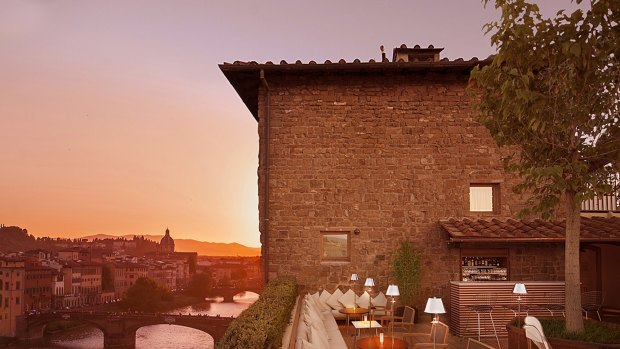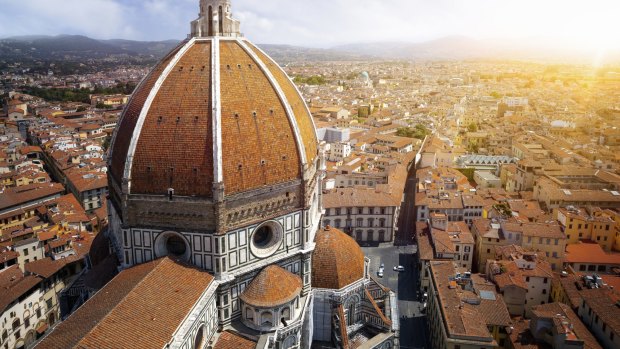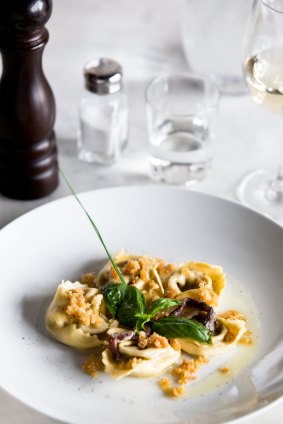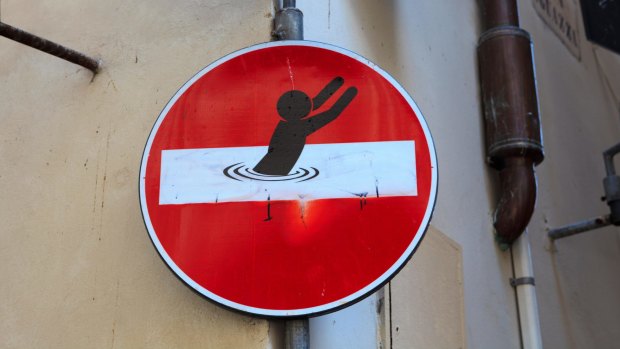This was published 9 years ago
Florence, Italy: The birthplace of the Renaissance embraces a new cool flavour
By Ellen Connolly

A view of Florence from the Hotel Continentale.
Renowned for its centuries-old palazzi and iconic sculptural masterpieces, Florentines pride themselves on their city's history, food and art. So when it comes to change, locals have been intensely stubborn, food tour operator Toni Mazzaglia tells me as we wind our way through Florence's crowded Mercato Centrale, a rustic, dimly lit market established in 1874.
According to Mazzaglia, who runs Taste Florence food tours, when shiny new food court Primo Piano opened above the old market last year, many refused to step foot in it.
"Everybody was resistant to it," Mazzaglia says.

The spectacular Duomo is the city's best-known landmark.Credit: iStock
"Now they see that it can only improve the quality of the city. That's what's crazy about Italy – this juxtaposition of old and new. They are fighting each other but accepting each other, too."
The sleek, sun-drenched culinary space, with its high ceilings and uber-cool design, offers communal dining, a wine bar and cooking school.
Chefs decked out in white uniforms and top hats make pizza and pasta from open-air kitchens, while counter after counter offers selections of cheese, fruit, bread, desserts, wine, beer and truffles.

Tradition meets modernity at Il Santo Bevitore.
Downstairs, Mazzaglia leads us to the oldest eatery in Florence's Mercato Centrale, a no-frills outlet where we join the queue for a local speciality: a spicy pork brisket sandwich.
In Florence, hotels are helping to revitalise the city, too, led by Italian fashion house Salvatore Ferragamo, which has opened four funky establishments.
We're staying at the Hotel Continentale, our room a romantic retreat with a private balcony overlooking the magnificent Arno River.

Hotel Continentale.
Sheer, billowy veils surround the four-poster bed, and in the large bathroom we have a daily cache (yes, they refill) of Ferragamo bath and beauty products.
Other modern touches include an iPad in the elevator, so you can choose music and take photos, a day spa and relaxation room, and a hotel webcam, which delivers views of the people crossing the Ponte Vecchio. At sunset, there's a rooftop bar and terrace for cocktails and exquisite views of the Duomo and beyond.
In a cute nod to Florence's past, the Hotel Continentale, part of Design Hotels, plays European movies from the 1950s on a large plasma screen in its lobby, and old black-and-white photos of Italian fashionistas from that era adorn the walls.

A road sign altered by street artist Clet Abraham.Credit: Alamy
Historical landmarks, including the Uffizi Gallery and Duomo, are within walking distance. A pleasant stroll along cobblestone streets leds us to Il Santo Bevitore, a restaurant that strikes a balance between traditional and modern.
In a former coach house and with a rustic interior – dark wooden furniture and flickering candles – the menu weaves traditional dishes, such as the robust papa al pomodoro, with modern ones, including warm almond soup with parma ham and figs. Other offerings include confit duck thigh with turnip blossoms, and rabbit thigh stuffed with liver. Even Florence's famous restaurant Cibreo Ristorante, established in 1979 by flamboyant chef Fabio Picchi, has added a contemporary edge, opening a modern private club, Teatro del Sale. Aimed at younger audiences, each week the club stages performances ranging from cabaret and jazz to comedy and drama. An extravagant two-hour buffet before each theatre shows is regarded as one of the best value meals to be had in the city.
Within view of the club is the original and historic Cibreo Ristorante, a fine-dining establishment, part of the Cibreo empire. Its degustation menu draws foodies to the city and is an event in itself. There is no printed menu, the dishes change daily based on the seasonal produce from the morning's market. Instead, a waiter pulls up a chair with diners and talks them through what is available. And Cibreo Ristorante prides itself on being a pasta-free zone.
For those wanting retail therapy, the usual big name luxury fashion houses – Versace, Gucci, and Prada – dominate, but a variety of lesser-known stores are attracting plenty of buzz.
Via del Corso is lined with interesting stores, including Piero Puliti, an Italian men's fashion store that specialises in one-off shirts and ties.
Along Via della Spada there is the exquisite Antica Officina del Farmacista, stocked with an enormous array of perfumes concocted from recipes and formulas dating back to the 1500s.
The newly opened MIO is a treasure trove of gifts; a narrow two-storey space packed with an eclectic mix of fascinating and unique designs. The owner supports local artists and designers who produce unusual jewellery, recycled bags and cool homewares. Work by street artist Clet Abraham is on display and some of his famed street signs are for sale. Abraham lives in Florence and is renowned for his night-time jaunts throughout Europe in which he graffitis street signs to change their meaning. Other fun finds at MIO include designer watches made from recycled wood and a bookmark that doubles as a magnet of Florence's skyline.
Across the street from many contemporary stores stands one of the oldest butcher shops in Florence – proving that new establishments can happily work in harmony with historic treasures.
TRIP NOTES
MORE INFORMATION
GETTING THERE
Return flights from Sydney to Rome with all major airlines. Trains connect Rome with Florence hourly and take about 90 minutes. See www.italiarail.com
STAYING THERE
Hotel Continentale, Florence; see www.designhotels.com/continentale
EATING THERE
Il Santo Bevitore, see ilsantobevitore.com
Cibreo Ristorante, see info@cibreo.com
SEE + DO
Taste Florence food tour, see tasteflorence.com
Teatro del Sale, nightly theatre performances, see www.edizioniteatrodelsalecibreofirenze.it
The writer travelled with the assistance of Hotel Continentale.
FIVE CLASSIC FLORENCE SIGHTS
THE DUOMO
The Basilica di Santa Maria del Fiore, known simply as the Duomo after its magnificent octagonal dome, is without doubt Florence's most recognisable landmark. Erected in the 14th century, the Gothic-style cathedral stands tall over the city; its facade is beautiful and intricate, covered in a breathtaking mix of pink, green and white marble. You can climb the 463 stairs to the top to see the inside of the dome. The ascent takes you past Giorgio Vasari's frescoes of the Last Judgment. Mass services and other religious ceremonies are open to the public. Closed Sundays. See www.accademia.org
GALLERIA DELL'ACCADEMIA
Mention you are visiting Florence and most people will tell you simply, "David". They are referring to Michaelangelo's statue of David, at the Galleria dell'Accademia. Queues to see Florence's most popular sight can be as monumental as the statue itself, so plan ahead. The gallery's website recommends pre-purchasing tickets. Select an allotted time and smugly bypass the queue. Music lovers will appreciate the collection of musical instruments from the Conservatory of Luigi Cherubini. Closed Mondays. See www.accademia.org
UFFIZI MUSEUM
Want to see work by Leonardo da Vinci, Botticelli, Raffaello, Caravaggio and Michelangelo? Head to the Uffizi Museum, in the centre of Florence. One of the world's greatest art museums, with 45 museum halls, it is home to a smorgasbord of paintings, drawings and sculptures, dating back to the 11th century. It's reportedly the most visited museum in Italy after the Vatican, so plan well in advance. Buy advance tickets, wear comfortable shoes and, if your time is limited, pinpoint the pieces you want to see. One of the most popular is Botticelli's Birth of Venus, as well as anything by Rembrandt. Need a break? Head to the rooftop cafe for some fresh air, caffeine and a magical view. Closed Mondays. See www.uffizi.org
PONTE VECCHIO
The Ponte Vecchio (old bridge) is one of the most photographed bridges in Europe, and at sunset it is easy to see why. The medieval structure, which connects the Uffizi to the Palazzo Pitti, is the most spectacular of the six bridges that cross the Arno River. Built in Roman times in 996, it was destroyed by floods (first in 1117 and later in 1333). The current bridge was rebuilt in 1345 and was the only one in Florence to escape any damage in World War II. The butchers and tanners that originally lined the bridge have long been replaced by high-end jewelery stalls, art galleries and souvenir shops. Legend has it that if lovers place a lock on the Ponte Vecchio and toss the key into the Arno River, their love will last forever.
PALAZZO PITTI
Palazzo Pitti is Florence's largest museum complex. This enormous palace houses several important museums, including the Royal Apartments, the Silver Museum, the Gallery of Modern Art, the Costume Gallery and the Porcelain Museum. Originally built for the Pitti family in 1457, it was bought by the Medicis in 1549 where it became the royal residence of the Grand Ducy of Tuscany. After working your way through the many galleries, head outside to the Giardinio di Boboli, a beautiful park with a magnificent collection of Italian sculptures, lush gardens and fountains.
Sign up for the Traveller Deals newsletter
Get exclusive travel deals delivered straight to your inbox. Sign up now.